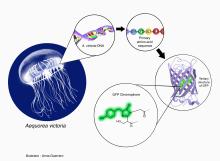Filter my results


Lysogenic bacteria, or virus-infected bacteria, were the primary experimental models used by scientists working in the laboratories of the Pasteur…
ContextInstitut Pasteur (Paris, France)BacteriaEscherichia coliMonod, Jacques
When cells-but not DNA-from two or more genetically distinct individuals combine to form a new individual, the result is called a chimera. Though…
ContextChimerismEmbryosEmbryonic Stem CellsMosaicism
All cells that have a nucleus, including plant, animal, fungal cells, and most single-celled protists, also have mitochondria. Mitochondria are…
CellsCell organellesMitochondriaPlant mitochondriaEndosymbiosis
Golden Rice was engineered from normal rice by Ingo Potrykus and Peter Beyer in the 1990s to help improve human health. Golden Rice has an engineered…
TechnologyRiceBiotechnologyGenesMolecular Biology
In 2007, Françoise Baylis and Jason Scott Robert published “Part-Human Chimeras: Worrying the Facts, Probing the Ethics” in The American Journal of…
LiteratureChimerismNeuronsChimeraGenetics
In 2006, bioethicist Jason Scott Robert published “The Science and Ethics of Making Part-Human Animals in Stem Cell Biology” in The FASEB Journal.…
LiteratureGeneticsbioethicsStem Cell ResearchStem Cells
Thalidomide is a sedative drug introduced to European markets on 1 October 1957 after extensive testing on rodent embryos to ensure its safety. Early…
ContextTeratogenicity testingAbnormalities, HumanThalidomide--Side effectsThalidomide
The crystal jellyfish, Aequorea victoria, produces and emits light, called bioluminescence.
Green fluorescent proteinFluorescent polymersProteinsBiofluorescenceLuminescence
Apoptosis, or programmed cell death, is a mechanism in embryonic development that occurs naturally in organisms. Apoptosis is a different process…
ApoptosisGenetic regulationCaenorhabditis elegansCellsGerm Cells
Bacteria of the genus Wolbachia are bacteria that live within the cells of their hosts. They infect a wide range of arthropods (insects, arachnids…
WolbachiaBacteriaHost-bacteria relationshipsHost-parasite relationshipsArthropods